
Easy DIY Wooden Candle Holders for Weddings and Special Occasions
Enhance the ambiance of your wedding or any special occasion with elegant and personalized wooden candle holders. These handcrafted pieces add a touch of warmth, rustic charm, and sophistication to your decor. This guide provides step-by-step instructions and inspiring ideas to create stunning wooden candle holders that perfectly complement your event theme.
Choosing the Right Wood
The first step is selecting the right wood for your candle holders. Consider the following factors:
Wood Type
- Pine: Softwood, readily available, affordable, and easy to work with. Offers a natural, rustic look.
- Oak: Hardwoods, durable, and strong. Provide a classic and elegant aesthetic.
- Cedar: Aromatic wood, known for its natural insect repellent qualities. Offers a warm, earthy tone.
- Reclaimed Wood: Unique character and history. Creates a vintage and eco-friendly look.
Wood Thickness
Choose a thickness that provides stability and can hold the weight of the candles. For smaller candle holders, 1/2-inch thick wood is suitable. For larger holders, consider using 3/4-inch thick wood or thicker.
Design Inspiration
Get inspired by various design ideas to create unique candle holders that reflect your style and the theme of your event. Here are some popular options:
Simple and Elegant
- Cut round or square pieces of wood to create a basic platform for the candle.
- Sand the edges for a smooth finish.
- Use a wood stain or paint to add color and a polished look.
Rustic Charm
- Use rough-cut wood with knots and natural imperfections for a rustic feel.
- Leave the edges natural or lightly sand them for a distressed look.
- Use a natural wood finish or a dark stain to enhance the wood’s character.
Geometric Shapes
- Cut wood into geometric shapes like triangles, squares, or hexagons.
- Create layers of wood pieces to form a unique design.
- Use contrasting wood stains or paints for a visually appealing effect.
Floral Motifs
- Use wood-burning tools to create intricate floral designs on the wood surface.
- Carve delicate flower patterns for a more elaborate look.
- Paint the designs with metallic paints or acrylics to add a touch of glamour.
Tools and Materials
Gather the necessary tools and materials to ensure a smooth and enjoyable DIY experience. Here’s a list of essentials:
Tools
- Saw (hand saw, circular saw, jigsaw)
- Sandpaper (various grits)
- Drill
- Screwdriver
- Wood glue
- Clamps
- Measuring tape
- Pencil
- Wood burning tool (optional)
Materials
- Wooden planks
- Candles
- Wood stain or paint
- Protective finish (varnish, sealant)
- Decorative elements (beads, ribbon, dried flowers)
Step-by-Step Instructions
Follow these step-by-step instructions to craft your own stunning wooden candle holders:
Step 1: Prepare the Wood
- Cut the wooden planks to your desired size and shape using a saw.
- Sand the edges and surfaces with sandpaper to create a smooth finish.
- If using reclaimed wood, make sure to remove any loose nails or staples.
Step 2: Design and Create the Base
- If creating a simple base, cut a round or square piece of wood to fit the candle size.
- For more elaborate designs, use multiple pieces of wood to create layers, geometric shapes, or floral motifs.
- Secure the pieces together with wood glue and clamps.
Step 3: Add Decorative Elements (Optional)
- Use a wood burning tool to create designs on the wood surface.
- Carve intricate patterns for a more detailed look.
- Paint the designs with metallic paints, acrylics, or wood stains.
- Decorate with beads, ribbon, dried flowers, or other elements that complement your style.
Step 4: Apply Finish
- Apply a wood stain or paint to enhance the color and create the desired look.
- Apply a protective finish, such as varnish or sealant, to protect the wood and enhance its durability.
Tips and Considerations
Here are some tips and considerations to ensure a successful project:
Safety First
- Always wear safety glasses and a dust mask when working with wood.
- Use clamps to hold the pieces firmly in place during the gluing process.
- Allow the glue to dry completely before handling the candle holders.
- Place the candle holders on a heat-resistant surface to avoid damage.
Customization Options
- Experiment with different wood types, stains, paints, and finishes to create unique looks.
- Add personal touches by incorporating your initials, wedding date, or other special messages.
- Decorate the candle holders with flowers, greenery, or other decorative elements that complement your event theme.
Conclusion
Creating DIY wooden candle holders is a rewarding and creative project that allows you to personalize your wedding or any special occasion. By following these instructions and embracing your creativity, you can craft stunning candle holders that add a touch of warmth, elegance, and charm to your celebration.








